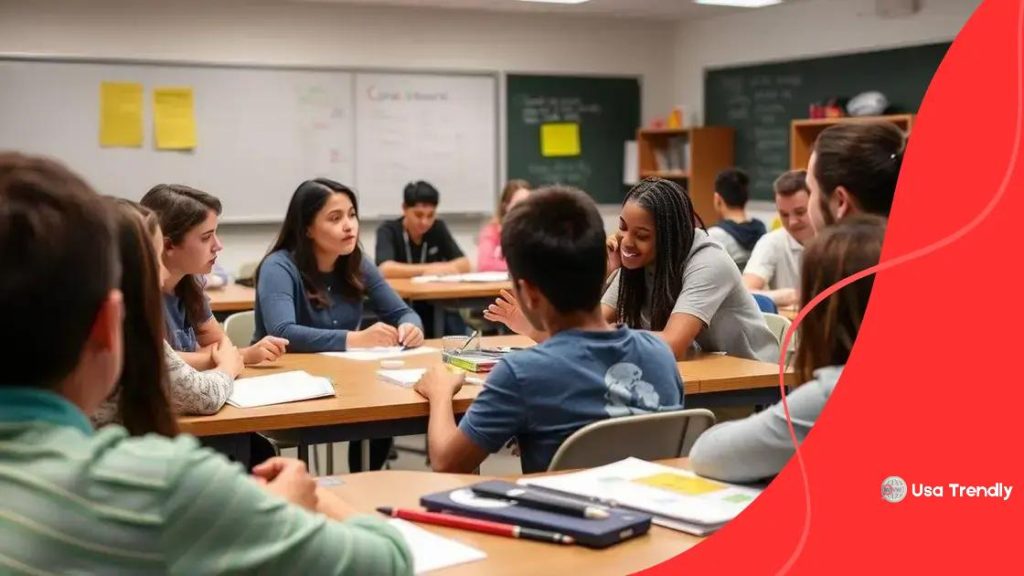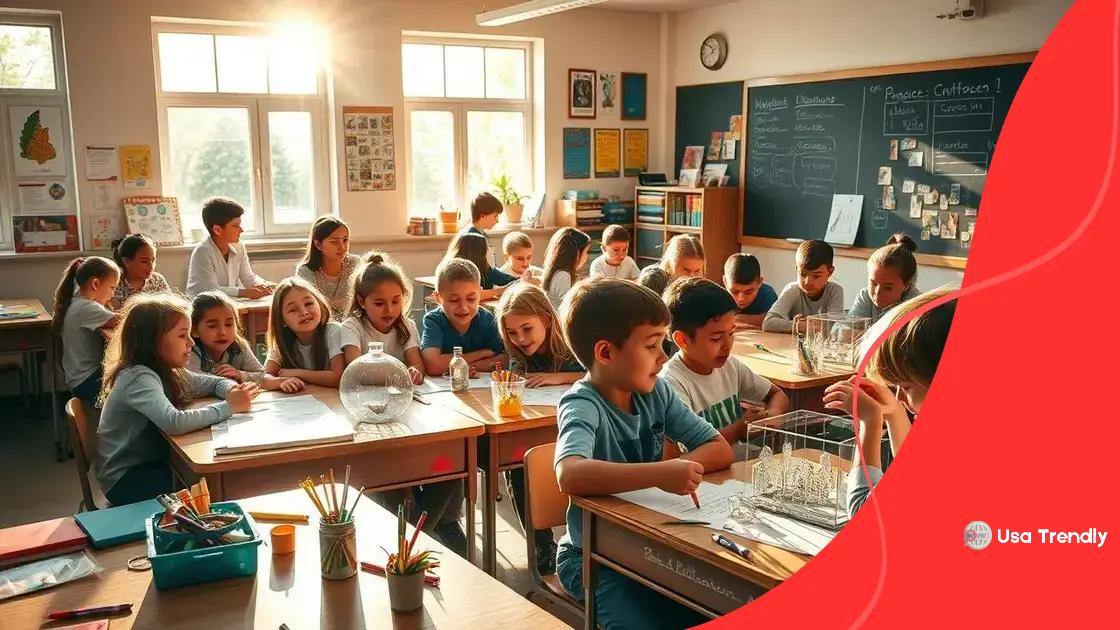Active learning best practices to enhance your teaching

Active learning techniques enhance student engagement and retention by involving them directly in the learning process through collaborative and hands-on activities, while addressing challenges like resistance and resource limitations.
Active learning best practices are game changers in modern education. By fostering engagement and participation, these approaches can significantly enhance student understanding. Have you considered how these methods might transform your teaching?
Understanding active learning principles
Understanding active learning principles is essential for modern educators. These principles foster engagement and help students take charge of their learning. At its core, active learning encourages students to participate directly in the process rather than passively receiving information.
Active learning can transform a classroom into an interactive environment. By applying these principles, teachers can motivate students to think critically and engage more deeply with the material. Much research shows that when students are actively involved, retention rates soar, and they develop a genuine interest in the subject.
Core Principles of Active Learning
To implement effective active learning strategies, consider these core principles:
- Engagement: Foster active participation through discussions, group work, and projects.
- Collaboration: Encourage teamwork to foster social learning and diverse perspectives.
- Feedback: Provide timely feedback to guide students and reinforce their learning.
Another crucial aspect is to create a safe space for students to express their thoughts and ideas. When they feel comfortable, they are more willing to take risks, ask questions, and share their insights. This atmosphere builds a strong community of learners.
Incorporating Active Learning in Lessons
As you plan your lessons, incorporate activities aligned with active learning principles. Here are some effective approaches:
- Think-Pair-Share: Students think about a question, pair up to discuss their thoughts, and then share with the class.
- Group Projects: Small groups can collaborate on assignments to enhance learning through peer interaction.
- Interactive Lectures: Integrate pauses during lectures for students to discuss or reflect on key concepts.
By including these elements in your teaching, you can foster a dynamic learning environment. Regularly assessing how well active learning strategies are working can help make necessary adjustments. This feedback loop ensures that students are not only learning but also enjoying the process.
Benefits of active learning techniques
The benefits of active learning techniques are numerous and impactful. These methods promote deeper understanding and retention of knowledge among students. Additionally, they help develop critical thinking and problem-solving skills that are essential for success in life.
When students engage actively, they become more invested in their learning. This investment often leads to higher achievement and satisfaction in their educational journey. Research shows that classrooms using active learning report increased attendance and participation.
Improved Retention Rates
One major benefit of active learning is enhanced retention of information. When students participate in discussions or work on group projects, they process the material more thoroughly. This engagement allows them to make connections and apply what they’ve learned in practical ways.
- Experiential Learning: Hands-on activities allow students to experience concepts firsthand, making learning more memorable.
- Peer Teaching: Explaining ideas to peers reinforces students’ understanding and clarifies their thoughts.
- Regular Feedback: Teachers can provide immediate feedback during activities, helping students adjust their understanding quickly.
In addition, these techniques foster a sense of community among learners. By working together, students learn from each other. This collaborative atmosphere encourages open dialogue and supports diverse viewpoints.
Increased Engagement
Active learning techniques boost student engagement significantly. When students take charge of their learning, they feel more motivated. Teachers can create a lively classroom by introducing activities that require collaboration and creativity.
- Group Work: Students can solve problems together, sharing their strengths and ideas.
- Interactive Questioning: Teachers ask questions that require students to think critically and respond actively.
- Gamification: Turning lessons into games can spark enthusiasm and a competitive spirit.
Creating an atmosphere where students feel comfortable taking risks is crucial. As they express their thoughts, their confidence grows, leading to richer discussions. Ultimately, the transformation from passive to active learning shapes well-rounded individuals who think for themselves.
Engaging activities for your classroom

Engaging activities for your classroom are key to implementing active learning techniques. These activities not only capture students’ attention but also make learning fun and effective. When students participate actively, they retain information better and develop skills that will benefit them in the future.
There are many ways to create engaging activities. Incorporating movement and collaboration can foster excitement. For example, using hands-on projects allows students to explore concepts in a tangible way, making lessons more relevant to their lives.
Group-Based Learning Activities
Group-based learning is a fantastic way to energize the classroom. When students work together, they share ideas and learn from one another. Consider these engaging formats:
- Jigsaw Activities: Assign different topics to each group and have them teach their findings to others.
- Debates: Encourage students to explore different viewpoints on a subject, developing critical thinking skills.
- Role-Playing: Use scenarios to help students apply concepts creatively and understand perspectives.
These activities create a dynamic classroom environment. When students communicate and collaborate, they build relationships and enhance their learning experience.
Hands-On Projects
Hands-on projects are wonderful for making learning interactive. Students can apply theories to real-world situations, deepening their understanding. Here are a few ideas:
- Science Experiments: Conduct experiments that align with lessons to spark curiosity and engagement.
- Art Integration: Allow students to express their understanding of concepts through art projects.
- Community Projects: Involve students in projects that benefit the community, instilling a sense of responsibility.
Ultimately, the goal of engaging activities is to create a lively and inclusive classroom. When students feel like active participants, their learning experience becomes more enjoyable and meaningful. Incorporating these techniques can lead to a positive shift in learning outcomes.
Assessing student progress in active learning
Assessing student progress in active learning is crucial for understanding how well these techniques impact learning outcomes. When educators use active learning, they need effective ways to measure progress and engagement. Regular assessment allows teachers to adjust their strategies and better meet students’ needs.
Various methods can be used to assess progress in an active learning environment. Continuous feedback helps students understand their strengths and areas for improvement. It also allows teachers to gauge how well concepts are understood, leading to more effective instruction.
Formative Assessment Techniques
Formative assessments are key in active learning. They provide insights into student progress throughout a lesson. Here are some effective strategies:
- Exit Tickets: Students write a quick summary or answer a question before leaving class.
- Peer Review: Allow students to assess each other’s work, fostering collaboration and critical thinking.
- Interactive Quizzes: Use technology to create quizzes that provide instant feedback.
This type of assessment encourages students to reflect on their learning and identify what they need to focus on. It helps them take ownership of their education.
Summative Assessment Methods
While formative assessments are ongoing, summative assessments evaluate student learning at the end of a unit. These methods help measure the overall effectiveness of active learning techniques. Consider these options:
- Projects: Allow students to showcase what they’ve learned through creative assignments.
- Presentations: Have students present their understanding of topics, demonstrating comprehension.
- Standardized Tests: Use these to benchmark progress against wider educational standards.
Both types of assessments play an important role in ensuring students are meeting learning objectives. In an active learning setting, feedback should be timely and constructive. This approach helps scaffold student understanding and encourages a growth mindset.
Overcoming challenges in implementing active learning
Overcoming challenges in implementing active learning is essential for educators who want to enhance student engagement. Although these techniques can provide significant benefits, various obstacles may arise. From resistance to change to resource limitations, understanding these challenges can help teachers navigate them more effectively.
One major challenge is the traditional mindset that often prevails in education. Some educators and students may prefer familiar lecture-based methods to more interactive approaches. To address this, teachers can begin by gradually introducing active learning strategies. This gradual shift can help everyone adapt without feeling overwhelmed.
Addressing Resistance
Resistance can come from students who are uncomfortable with new methods or even from administration that favors conventional teaching styles. Overcoming this resistance involves clear communication about the benefits of active learning. Here are some strategies to consider:
- Educate Stakeholders: Share research findings and examples of successful active learning outcomes with colleagues and administrators.
- Involve Students: Get student feedback to demonstrate their interest and willingness to engage in active learning activities.
- Offer Training: Provide professional development opportunities for teachers to learn about active learning techniques.
These methods can help shift perceptions and create a more supportive environment for active learning.
Resource Limitations
Another challenge is the availability of resources, such as materials and technology. Many active learning activities require specific tools or supplies, which can be hard to come by in some schools. To overcome this hurdle, teachers can:
- Utilize Existing Resources: Identify and leverage materials already available in the classroom or school.
- Collaborate: Partner with other educators to share resources and ideas for active learning.
- Be Creative: Design low-cost or no-cost activities that don’t require extensive materials or technology.
By thinking outside the box, educators can implement effective active learning strategies regardless of limited resources.
Ultimately, patience and flexibility are vital when implementing new teaching approaches. Active learning is a journey and educators may face setbacks along the way. However, with determination and teamwork, it is possible to overcome these challenges and create a vibrant learning environment.
FAQ – Questions about Active Learning Techniques
What are active learning techniques?
Active learning techniques are instructional methods that engage students directly in the learning process, encouraging participation and collaboration.
How can I overcome resistance to active learning in my classroom?
To overcome resistance, educate both students and colleagues about the benefits, involve them in discussions, and gradually introduce new strategies.
What are effective ways to assess student progress in active learning?
Effective assessment methods include formative assessments like exit tickets, peer review, and interactive quizzes, along with summative assessments like projects and presentations.
How can resource limitations be addressed when implementing active learning?
Resource limitations can be managed by utilizing existing materials, collaborating with other educators, and designing low-cost activities.
